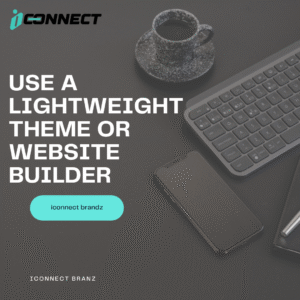Is your website taking forever to load? Are your visitors leaving before they even see your content? If yes, then your page speed and Core Web Vitals might be the reason. And here’s the good news: you don’t need to touch a single line of code to fix it.
As a digital marketing consultant in the USA, I’ve worked with all kinds of clients—from startups in Miami to full-service digital marketing firms in New York. Most of them think they need a developer to speed up their website. But in reality, there are many no-code ways to improve your Core Web Vitals and give your audience a faster, smoother experience.
In this article, I’ll show you how to optimize page speed and Core Web Vitals without any coding. Whether you’re a small business owner in Chicago or run a digital marketing agency in Los Angeles, these steps are simple, practical, and beginner-friendly.
What Are Core Web Vitals and Why Should You Care?
Core Web Vitals are a set of specific factors Google uses to measure the user experience on your website. These include:
- Largest Contentful Paint (LCP): How long it takes for the main content to load
- First Input Delay (FID): How quickly your site reacts when someone clicks something
- Cumulative Layout Shift (CLS): Whether your page jumps around while loading
These metrics are now a direct Google ranking factor. So if your site is slow, even the best digital marketing services for small business USA won’t help unless you fix it.
Choose a Fast Hosting Provider
One of the easiest ways to boost your page speed is by switching to a faster hosting provider. Even without code, your hosting plays a huge role in how quickly your website loads.
Tips:
- Use cloud hosting like SiteGround, Kinsta, or WP Engine
- Avoid cheap shared hosting plans
- Go for hosting with built-in caching
This step alone can make a big difference, especially if you’re a local SEO company in Phoenix or a content marketing firm in Seattle trying to compete in crowded spaces.
Use a Lightweight Theme or Website Builder

If you’re using WordPress, your theme could be slowing you down.
What to do:
- Switch to a fast, lightweight theme like Astra or GeneratePress
- Avoid bloated themes with too many features
- Use page builders like Elementor or Oxygen that are speed-optimized
This is a no-code fix that can instantly improve your website’s LCP and CLS.
Compress Your Images
Images are often the heaviest part of a web page. But the good thing is, you can compress them without losing quality.
How to do it:
- Use free tools like TinyPNG, ShortPixel, or ImageOptim
- Convert images to next-gen formats like WebP
- Upload smaller image dimensions (e.g., 1200×800 instead of 5000×3000)
If you’re a social media marketing agency in Houston posting visual content daily, compressing your images is a must.
Use a Caching Plugin (No Coding Needed)
Caching stores a version of your site so it loads faster next time. For WordPress, you can use caching plugins that don’t require any code.
Top plugins:
- WP Rocket (paid, but very powerful)
- W3 Total Cache (free)
- LiteSpeed Cache (for LiteSpeed servers)
Even digital media companies in Austin can benefit from this simple trick to improve speed site-wide.
Optimize Fonts and Remove Unused Styles
Custom fonts look great but slow down your website. You can manage them easily without coding.
What to do:
- Use system fonts or host Google Fonts locally
- Limit the number of fonts and weights
- Use tools like “Asset CleanUp” or “Remove Unused CSS” plugins to clean up CSS
This helps reduce layout shift (CLS)—a key Core Web Vital.
Use a CDN (Content Delivery Network)
A CDN helps deliver your site faster by loading content from the closest server to your user.
Popular CDN providers:
- Cloudflare (free plan available)
- BunnyCDN
- StackPath
Even if you run a digital advertising agency in Miami or a performance marketing agency in Atlanta, this can significantly improve your load times.
Delay or Defer Third-Party Scripts
Many websites use third-party scripts for ads, tracking, or chat widgets. These can slow down your site.
What you can do (without code):
- Use “Flying Scripts” plugin to delay loading scripts
- Use Google Tag Manager to control when tags load
- Remove unnecessary plugins and scripts
For example, if you use a Facebook marketing agency USA, make sure only the needed scripts are loading on your homepage.
Monitor Your Progress With Free Tools
You don’t need to guess whether your fixes are working. Use these tools to track your progress:
- PageSpeed Insights (by Google)
- GTmetrix
- WebPageTest
They will show your Core Web Vitals scores and suggest more no-code improvements. Perfect for any ROI-focused marketing agency or freelancer.
Conclusion: Speed Up Without the Stress
You don’t have to be a developer to optimize your website. You just need the right tools and a little time.
From affordable digital marketing services in Las Vegas to top-rated agencies in New York, everyone can benefit from a faster website. By following these steps, you’ll improve your page speed, boost your Core Web Vitals, and make both Google and your visitors happy.
The best part? You did it all without writing a single line of code.
FAQs
Can I fix page speed without hiring a developer?
Yes! Use simple plugins, image tools, and hosting solutions. No coding needed.
What are the easiest tools to start with?
Try WP Rocket for caching, TinyPNG for images, and Cloudflare CDN. These tools are user-friendly.
How fast should my site load?
Under 3 seconds is great. Under 2 seconds is ideal for user experience and SEO.
Does page speed really affect SEO rankings?
Absolutely. Google has made Core Web Vitals a confirmed ranking factor.
Can slow sites lose customers?
Yes. Studies show that users leave websites that take longer than 3 seconds to load.




